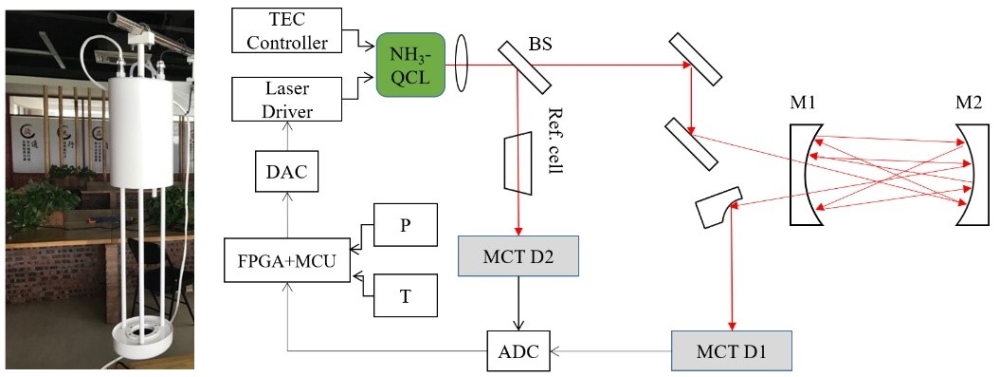Scientists Develop a New Instrument to Measure Atmospheric Ammonia
Date:2021-08-13
In the past decades, intensive human agricultural activities have caused a significant increase in ammonia (NH3) emissions to the atmosphere, which have led to serious environmental and public health problems. Accurate quantification of NH3 emissions from agricultural ecosystems is essential for the understanding of NH3 budgets at regional to global scales as well as for the control and mitigation strategies on air pollution.
Scientists at the Institute of Atmospheric Physics of the Chinese Academy of Sciences and their collaborators from Ningbo HealthyPhoton Co., Ltd. have developed a portable and solar-powered open-path NH3 analyzer (model: HT8700). This analyzer is specifically designed for NH3 flux measurement based on the eddy covariance (EC) method, the most direct and effective way to measure NH3 exchanges between terrestrial ecosystems and the atmosphere. The team investigated the analyzer's suitability to measure NH3 fluxes through laboratory and field experiments and published their study in Agricultural and Forest Meteorology.
A flux system based on the EC method requires an NH3 analyzer with high sensitivity and fast response. For the conventional closed-path NH3 instruments, the surface adsorption effect of NH3 causes longer response time and therefore introduce measurement bias. Meanwhile, the sampling pumps for the closed-path systems usually require high power consumption, which makes them not feasible in field deployments particularly in places where grid power is not readily available.

Figure1 A picture of the HT8700 open-path ammonia analyzer and its technical design. (Image by KANG Peng)
"The availability of the new instrument for the flux community allows us to monitor the NH3 flux, both emissions and depositions, at different types of ecosystems." said Dr. WANG Kai, the lead author of the work.
The HT8700 NH3 analyzer is based on the state-of-art quantum cascade laser absorption spectroscopy (QCLAS) technique. Its open-path design overcomes the challenges faced by the close-path instruments. With good performance in terms of response time, precision and stability, this instrument is an ideal tool for NH3 flux measurements based on the EC technique.

Figure 2 Eddy covariance flux measuring system for ammonia. (Image by WANG Kai)
"The field experiment proved the importance of open-path design for NH3 flux observation, but we think there are more opportunities for improvement in the future." said Dr. WANG Yin, one of the study's co-authors, CEO of HealthyPhoton Co., Ltd. "its data availability is largely constrained by frequent reductions in the laser signal intensity, because the optical mirrors are directly exposed to the environment. An automatic mirror cleaning design is being developed. It will make this instrument more suitable for long-term and automated measurements especially under dusty field conditions."
Citation:Wang K.*, Kang P., Lu Y., Zheng X.H., Liu M.M., Lin T.J., Butterbach-Bahl K., Wang Y.*, 2021. An open-path ammonia analyzer for eddy covariance flux measurement. Agricultural and Forest Meteorology 308–309: 108570. https://doi.org/10.1016/j.agrformet.2021.108570
Media contact: Ms. LIN Zheng, jennylin@mail.iap.ac.cn
